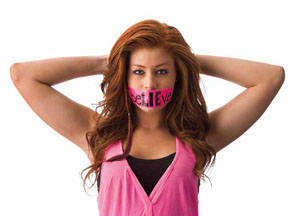articles/Lighting/ma-page2
Dave Montizambert creating with light Part 33 More Apertures - part 2 of 1 2 3
by Dave Montizambert Published 01/10/2014

To learn a bit about working with metering and apertures, look to Image 001 and Diagram 002: in this image the camera was set to f-8 to correctly expose the subject with the main light, a reflective meter reading off the background read f-22; at f-22 what brightness will this background be in the resulting photograph? To figure this ratio out you simply compare the f-22 background reflective reading to the f-8 camera setting - a couple of helpful facts to remember is that whatever your camera is set to represents middle grey and that all meter readings are relative to middle grey. So a background that reads f-22 but is photographed through an f-8 aperture will render a background that looks three stops brighter than middle grey. Why is this the case? Well because f-22 is three stops more brightness than f-8. Photographers learning lighting and metering often mix this up and interpret it as three stops darker than middle grey. Why?
Well because once again they don't fully understand the basics.
In this case they think back to their early training and think that a highnumbered f-stop means little light, and it does in terms of how much light that aperture would let into the camera relative to f-2.8 for example, but there is more going on here than just that. When you point your reflective meter at a lit surface, the meter tells you an aperture, in this case the hand-held reflective meter is telling us to set our camera to f-22 to make this surface photograph as middle grey, only we are not going to do this because we have set the camera f-8 for a correct subject exposure. So, f-22 amount of light will have to pass through the much larger f-8 aperture opening which will make this background appear in the image as three stops brighter than middle grey - know that f-8 is an eight times bigger hole than f-22 and so eight times more light will pass through the aperture than it would through an f-22 hole. In the end, photographers are getting stuck on the fact that, yes f-22 does allow less light through than f-8, but that is not the issue - when you take a meter reading you have to think about what the meter is really saying and what your camera is set at. With a higher reflective reading, such as f-22, your meter is saying, "This area reads really bright so you better use a really small hole for an aperture", but we are not setting our camera exposure for this background, we are setting it for the main lit subject. Basically you have to ask yourself, "Am I metering for exposure, or am I doing comparative readings to see the brightness differences in my scene so you can fine tune my lighting accordingly?" Remember that whatever a reflective meter reads off, the meter will indicate an exposure setting to make that surface look middle grey. In the above scenario as in most shoots, we are not setting exposure for the background, we are setting it for the main lit subject - the reading off the background when compared to the camera setting tells you what brightness it'll photograph as, and it is that comparison or difference that is the lighting ratio. Of course if you don't like that brightness difference then you physically increase or decrease the amount of light on that surface to make it the way you want.
Please Note:
There is more than one page for this Article.
You are currently on page 2
- Dave Montizambert creating with light Part 33 More Apertures page 1
- Dave Montizambert creating with light Part 33 More Apertures page 2
- Dave Montizambert creating with light Part 33 More Apertures page 3
1st Published 01/10/2014
last update 09/12/2022 14:56:14
More Lighting Articles
There are 12 days to get ready for The Society of Photographers Convention and Trade Show at The Novotel London West, Hammersmith ...
which starts on Wednesday 14th January 2026





